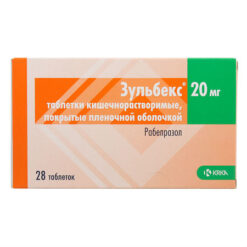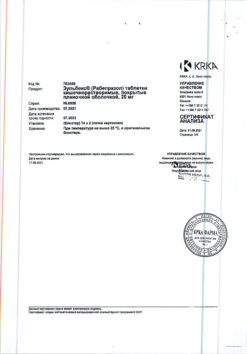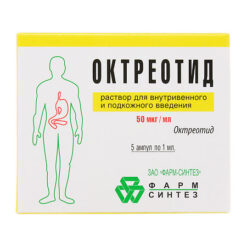No products in the cart.
Zulbecs, 20 mg 14 pcs
€1.00
Out of stock
(E-mail when Stock is available)
EAN: 3838989582203
SKU: 216341
Categories: Medicine, Stomach, intestines, liver, Ulcer and gastritis
Description
Zulbecs is an antiulcer.
Pharmacodynamics
Rabeprazole belongs to the class of antisecretory drugs, substituted benzimidazoles, which have no cholinolytic or antihistamine (H2) properties, but inhibit gastric secretion by inhibiting the enzyme H+/K+-ATPase (proton pump). The effect of the drug is dose-dependent and results in suppression of basal and stimulated gastric hydrochloric acid secretion, regardless of stimulating factors.
Animal studies have shown that rabeprazole rapidly disappears from plasma and gastric mucosa. As a weak base, rabeprazole is rapidly absorbed in all dosages and accumulates in the acidic environment of the parietal cells of the stomach. Rabeprazole is converted to the sulfenamide form by protonation and then interacts with available proton pump cysteine molecules.
Antisecretory action: after oral administration of 20 mg of rabeprazole, the antisecretory effect begins to develop within 1 h, reaching a maximum after 2-4 h. Suppression of basal and food stimulated secretion of hydrochloric acid in the stomach 23 h after the first dose of rabeprazole is 69% and 82%, respectively, and lasts up to 48 h.
The inhibitory effect of rabeprazole on hydrochloric acid secretion increases slightly with repeated doses, reaching an equilibrium state after 3 days. After discontinuation of the drug, gastric secretory activity is restored after 2-3 days.
In vitro it was found that rabeprazole has a bactericidal effect on Helicobacter pylori.Eradication of H. pylori with rabeprazole and antimicrobials leads to a high degree of healing of mucosal lesions.
According to the results of clinical studies it is established that administration of rabeprazole 20 mg 2 times a day in combination with two antibiotics, e.g. clarithromycin and amoxicillin or clarithromycin and metronidazole for 1 week allows to reach the eradication of H. pylori over 80% in patients with gastroduodenal ulcers.
When selecting the appropriate combination for H. pylori eradication, approved treatment standards should be followed.
In patients with persistent infection (in the presence of initially susceptible strains of microorganisms) the possibility of development of secondary resistance to antibiotics must be considered when choosing a dosing regimen.
Impact on serum gastrin: in clinical studies patients received rabeprazole in doses of 10 or 20 mg once daily for up to 43 months.
The serum concentration of gastrin increased in the first 2-8 weeks of therapy, reflecting the suppressive effect on hydrochloric acid secretion, and then remained stable with continuation of therapy. Gastrin concentrations usually returned to baseline values within 1-2 weeks after therapy withdrawal.
Biopsy specimens from the antral part and fundus of the stomach obtained from more than 500 patients receiving rabeprazole or comparative treatment for up to 8 weeks showed no changes in ECL cellular and histological structure, gastritis grade, incidence of atrophic gastritis, intestinal metaplasia, or prevalence of H. pylori in more than 250 patients followed for 36 months of therapy showed no significant changes in baseline conditions.
Other effects: systemic effects of rabeprazole on the CNS, cardiovascular and respiratory systems have not been identified to date.
Rabeprazole administered orally at a dose of 20 mg for 2 weeks had no effect on thyroid function, carbohydrate metabolism or circulating concentrations of parathormone, cortisol, estrogen, testosterone, prolactin, cholecystokinin, secretin, glucagon, FSH, LH, renin, aldosterone or STH.
Clinical studies have shown that rabeprazole has no clinically significant interaction with amoxicillin and no adverse effect on plasma concentrations of amoxicillin or clarithromycin when these drugs are used simultaneously to eradicate H. pylori in the upper GI tract.
Pharmacokinetics
Intake: The drug Zulbecs® is rabeprazole tablets coated in an enteric-soluble (gastric-stable) coating.
This form is due to the instability of rabeprazole in an acidic environment. Therefore, absorption of rabeprazole begins only after the tablet leaves the stomach. Absorption is rapid; Cmax of rabeprazole in plasma is reached approximately 3.5 h after an oral dose of 20 mg. Cmax and AUC are linear in the dose range from 10 mg to 40 mg.
The absolute bioavailability of an oral dose of 20 mg (compared with intravenous administration) is approximately 52%, largely due to presystemic metabolism.
The bioavailability does not appear to increase with repeated administration. In healthy subjects, the T1/2 from plasma is approximately 1 h (0.7 to 1.5 h) and total clearance is 283±98 ml/min. There is no clinically significant interaction associated with food intake. Neither food nor time of drug intake affects absorption of rabeprazole.
Distribution: In humans rabeprazole is approximately 97% bound to plasma proteins.
Metabolism and excretion: Rabeprazole, like other representatives of the class of proton pump inhibitors, is metabolized in the liver, with the participation of cytochrome P450 (CYP450). In vitro studies with human hepatic microsomes have shown that rabeprazole is metabolized by CYP450 isoenzymes (CYP2C19 and CYP3A4).
In these studies, rabeprazole did not inhibit or stimulate CYP3A4 at the expected plasma concentrations in humans. These results suggest that no interaction is expected between rabeprazole and cyclosporine.
In humans, the major metabolites detected in plasma are thioether (M1) and carboxylic acid (M6), and the sulfonic metabolite (M2), desmethylthioether (M4), and the mercapturic acid conjugate (M5) are determined in lower amounts. Only the desmethyl metabolite (M3) has little antisecretory activity, but it is not detected in plasma.
After a single oral dose of 20 mg of 14C-labeled rabeprazole, unchanged rabeprazole is not excreted by the kidneys. Approximately 90% of the administered dose is excreted by the kidneys as two metabolites: mercapturic acid conjugate (M5) and carboxylic acid (M6), and as two unknown metabolites. The rest of the administered drug is found in the intestinal contents.
Gender: Adjusted for height and body weight, there were no sex differences in the pharmacokinetic parameters of rabeprazole in the 20 mg dose.
Renal dysfunction: in patients with renal insufficiency requiring hemodialysis (cLcreatinine less than 5 ml/min/1.73 m2) the distribution of rabeprazole was similar to that in healthy volunteers. The AUC and Cmax in such patients were approximately 35% lower than those in healthy volunteers.
The mean T1/2 of rabeprazole was 0.82 h in healthy volunteers, 0.95 h in patients on hemodialysis and 3.6 h after hemodialysis. The creatinine Cl of rabeprazole in patients with impaired renal function requiring maintenance hemodialysis was approximately 2 times higher than in healthy volunteers.
Hepatic impairment: after a single dose of 20 mg of rabeprazole in patients with mild to moderate liver disease, the AUC was 2-fold increased and the T1/2 of rabeprazole was 2-3-fold increased compared to healthy volunteers.
However, after a daily oral dose of 20 mg for 7 days, the AUC increased only 1.5-fold and the Cmax increased only 1.2-fold. The T1/2 of rabeprazole in patients with impaired liver function was 12.3 h, compared with 2.1 h in healthy volunteers. The pharmacodynamic response (gastric pH control) in the two groups was clinically comparable.
Elderly patients: The excretion of rabeprazole is slightly reduced in elderly patients. After using rabeprazole for 7 days at a daily dose of 20 mg, the AUC increased approximately 2-fold and the Cmax increased by 60% , the T1/2 was increased by 30% compared to healthy young volunteers. No evidence of rabeprazole accumulation was noted.
The CYP2C19 polymorphism: After oral administration of rabeprazole at a dose of 20 mg, AUC and T1/2 were approximately 1.9 and 1.6 times higher than the corresponding parameters in those with active metabolism, while Cmax was only increased by 40% in people with delayedCYP2C19-metabolism.
Indications
Indications
Active ingredient
Active ingredient
Composition
Composition
1 tablet contains:
The active ingredient:
rabeprazole sodium 20 mg;
Associates:
mannitol (E421);
magnesium oxide light;
Hyprolose;
Hyprolose low substituted;
Magnesium stearate.
How to take, the dosage
How to take, the dosage
Internal, whole, without chewing or breaking.
Gastric and 12 duodenal ulcer in the acute stage
20 mg once a day, in the morning.
In most patients an active duodenal ulcer heals within four weeks. However, some patients may need another four weeks for the ulcer to fully heal. An active benign gastric ulcer in most patients heals within six weeks.
In a small number of patients, however, it may take another six weeks to fully heal.
Gastroesophageal reflux disease (GERD): erosive reflux esophagitis (treatment), symptomatic treatment for GERD:
Take 20 mg once daily for four to eight weeks. With long-term therapy, a maintenance dose of Zulbecs of 10-20 mg once daily may be used, depending on the patient’s response to treatment.
The symptomatic treatment of GERD:
10 mg once daily in patients without esophagitis. If symptom control is not achieved within 4 weeks, further evaluation of the patient is necessary. Once the patient’s condition improves, further symptom control can be achieved with 10 mg once daily, on demand.
Zollinger-Ellison syndrome:
The recommended starting dose for adults is 60 mg once daily. The dose may be increased up to 120 mg daily depending on the individual patient’s needs. A daily dose of up to 100 mg once daily may be prescribed. A dose of 120 mg may require 6 times a day, 60 mg 2 times a day. Therapy is given as long as there is an appropriate clinical indication.
Eradication of H. pylori in patients with peptic ulcer disease or chronic gastritis:
Patients with H. pylor, should undergo eradication therapy. The following combinations of drugs are recommended for a course of 7 days: ® Zulbeccin 20 mg 2 times a day + clarithromycin 500 mg 2 times a day and amoxicillin 1 g 2 times a day.
If the eradication regimens require once-daily administration, Zulbecs must be taken in the morning, before breakfast; time of day and food intake have no effect on rabeprazole activity.
Renal and/or hepatic disorders:
Dose adjustment of Zulbecs is not required.
In children: due to insufficient data on efficacy and safety of rabeprazole the drug Zulbecs is not used in children.
Interaction
Interaction
Rabeprazole causes persistent and long-term inhibition of hydrochloric acid secretion in the stomach. There may be interaction with drugs, absorption of which depends on pH values. Concomitant use of rabeprazole with ketoconazole or itraconazole may lead to a significant decrease in their plasma concentrations, in connection with which dosage adjustment of these drugs may be required.
Proton pump inhibitors, including rabeprazole, should not be used concomitantly with atazanavir.
Rabeprazole has no clinically significant interaction with amoxicillin and with other drugs metabolized by cytochrome CYP450 enzymes, such as warfarin, phenytoin, theophylline and diazepam.
Rabeprazole slows down excretion of some drugs metabolized in the liver by microsomal oxidation (diazepam, phenytoin, indirect anticoagulants).
Concentrations of rabeprazole and the active metabolite clarithromycin in plasma are increased by 24% and 50%, respectively, when concomitantly administered. Reduces the concentration of ketoconazole by 33%, digoxin by 22%.
Special Instructions
Special Instructions
The reduction of symptoms during therapy with Zulbecz® does not rule out the presence of malignant neoplasms in the stomach or esophagus, therefore, before starting therapy, an examination to rule out a gastrointestinal neoplasm should be performed.
Patients receiving long-term therapy with Zulbecqs® (especially for more than one year) should be evaluated regularly.
The risk of cross-reactions with other proton pump inhibitors or with substituted benzimidazoles cannot be excluded.
The patient should be warned that the tablets should be swallowed whole and not chewed or crushed.
The use of Zulbecs® in children is not recommended because of lack of experience with this group of patients.
There have been reports of post-marketing studies about the development of blood dyscrasias (cases of thrombocytopenia and neutropenia) on the background of using rabeprazole. In most cases, when no alternative cause for these conditions could be found, they did not give any complications and disappeared after discontinuation of rabeprazole.
Zulbecs® may cause changes in liver enzyme activity that disappear after discontinuation of the drug.
In the study in patients with mild to moderate liver dysfunction there were no significant safety problems associated with the use of rabeprazole compared to a control group of healthy patients matched by gender and age. Because of the lack of clinical data on the use of rabeprazole in patients with severe hepatic dysfunction, caution is recommended when using Zulbecs® in this group of patients.
Impact on the ability to drive motor transport and other complex mechanisms:
Based on the properties of rabeprazole, it is unlikely that Zulbecce® may impair the ability to drive vehicles or affect operation of technical devices.
In case of side effects (drowsiness, dizziness, confusion) avoid driving and work requiring increased concentration and rapid psychomotor reaction.
Contraindications
Contraindications
With caution
Severe renal insufficiency.
Side effects
Side effects
Blood system: rare – neutropenia, leukopenia, thrombocytopenia, leukocytosis.
The immune system: rarely – hypersensitivity reactions.
Metabolism and nutrition disorders: rarely – anorexia, weight gain; very rarely – hyponatremia.
Nervous system disorders: often – headache, dizziness, insomnia; infrequent – somnolence, nervousness; rare – depression; very rare – confusion.
Sensory system disorders: rare – visual disturbances.
Systemic system disorders: very rare – peripheral edema.
Respiratory system: often – cough, pharyngitis, rhinitis; infrequent – bronchitis, sinusitis.
The digestive system: frequently – diarrhea, vomiting, nausea, abdominal pain, constipation, flatulence; infrequently – dyspepsia, dry mucous membrane of the mouth, belching; rarely – gastritis, stomatitis, change in taste, hepatitis, jaundice, hepatic encephalopathy.
The skin: infrequent – rash, erythema, rarely – itching, sweating, bullous rash, very rarely – erythema multiforme, toxic epidermal necrolysis, Stevens-Johnson syndrome.
Motor system disorders: often – nonspecific pain, back pain; infrequent – myalgia, cramps of the calf muscles, arthralgia.
Urinary system disorders: infrequent urinary tract infections; rarely – interstitial nephritis.
Reproductive system disorders: very rarely – gynecomastia.
Laboratory measures: infrequent – increased liver enzyme activity.
Others: often – asthenia, flu-like illness.
Overdose
Overdose
Existing experience with intentional or accidental overdose with rabeprazole is limited. The maximum established dose taken was not more than 60 mg twice daily or 160 mg once daily.
The effects were mild, consistent with the known spectrum of adverse reactions that resolved on their own without any additional medical intervention. A specific antidote is not known. Dialysis is ineffective.
Treatment: symptomatic.
Pregnancy use
Pregnancy use
Pregnancy
There are no data on the safety of rabeprazole during pregnancy in humans. Reproductive studies in rats and rabbits showed no evidence of impaired fertility or harmful effects of rabeprazole on the fetus.
The drug Zulbecs is not used during pregnancy.
Lactation
It is not known whether rabeprazole is secreted into the mother’s milk, but it is secreted into the milk of rats. No studies have been done in women during lactation.
If it is necessary to use Zulbecs during lactation, breastfeeding should be discontinued.
Similarities
Similarities
Additional information
| Shelf life | 2 years |
|---|---|
| Conditions of storage | At a temperature not exceeding 30 °C |
| Manufacturer | KRKA dd Novo mesto, Slovenia |
| Medication form | enteric soluble tablets |
| Brand | KRKA dd Novo mesto |
Other forms…
Related products
Buy Zulbecs, 20 mg 14 pcs with delivery to USA, UK, Europe and over 120 other countries.













